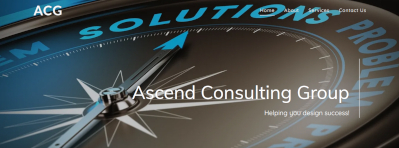Ascent Consulting Group
SERIES: Consultants in the Spotlight

Ascend Consulting Group is run by managing director Diana Vollmer. The Group seeks to aid business owners and their management teams to increase profits, company value and customer devotion. It’s a tall order that Ascend Consulting Group approaches strategically.
The Process

Vollmer said the company has a track record of success in two types of work. “We help lift profitable companies to an ever higher level of performance, and we seek to rescue struggling companies to return them to prosperity,” she said.
The consultants focus on six areas with their clients:
- Focus — Profit analysis and strategic business model refinements.
- Solutions — Practical, immediate, effective.
- Results — Objective holistic evaluation and adaptive restructuring.
- Experts — Specialists to address unique technical issues.
- Leaders — Coaching, instruction, writing.
- Succession — Buy/Sell/Internal transition.

Though it can be intimidating for a smaller company (say, a one-plant operation that just wants to do things more efficiently, or to add another location) to consider hiring a consultant, Vollmer says any size company can benefit from outside input.
“Companies that hire a consultant can gain insight into their current strengths and weaknesses and how to economically address both to improve their profitability,” she said. “Most recommendations pay for the consulting in the first 6-12 months after implementation. We have helped many, many small companies over the years.”
Getting started
Once you’ve made the decision to seek outside advice about the future options for your company, what happens next?
“A prospective client will be asked their specific goals and current status related to those goals,” Vollmer said. “The project will be customized to the client, their goals, and their budget. The process and project are very customized to the client’s situation and needs.”
Show and tell
The real proof of a consulting firm’s work is the successes their clients achieve after working with them. Vollmer was eager to share specific project outcomes, though client names are confidential. (You should be able to count on that with any consultant you hire.) In each case, she described the goal a client set, and the results they saw after working a plan with ACG.

- Goal: Increase profitable sales revenue of existing sales team.
- Results: By assessing the optimum client profile, product mix and pricing strategy, achieved revenue per sales FTE [Full Time Equivalent] increase of 28% in 6 months, with profit margin increase of 8%.
- Goal: Convert excess inventory and non-productive assets to cash.
- Results: Converted non-liquid limited purpose assets to cash with an increase in overall asset value of the company of 21%.
- Goal: To increase customer loyalty and market share of a well performing company.
- Results: Increase of 300+% within 18 months.
- Goal: Optimize product line and pricing strategy for an under-performing company.
- Results: After determining the impact of regional market opportunities and constraints, assessing and mitigating risk, utilizing current assets, successfully opened entire new product line and distribution channel that allowed expansion beyond existing markets.
- Goal: Plan for expansion of business-to-business revenues.
- Results: Company implemented plan and exceeded program goals in each of next 6 quarters (continuing into current 7th quarter with refinements).
Fear of Consulting
Hiring a consultant means you don’t know it all, and you’re asking for help. For some people, that’s a bridge too far. It also always involves expenditures. We asked Vollmer how she overcomes those mental blocks.
“There is a common misconception that consultants are unaffordable,” she said. In addition, “many management teams fear changes that will be recommended.
“The reality is that consultants’ fees are minor compared to the profitable improvements that result from executed projects. Fees can also be structured based on results. The fear of change, which is human nature, can be mitigated by the potential rewards. It can also be reduced by transparency and team involvement in the project goals and outcome.”

So what’s it cost?
“The initial no-risk/no-commitment consultation to discuss goals, status and needs is complimentary,” Vollmer said. “That is followed by a clear proposal where project fees are customized to fit the details of the project, timing, client budget and resources required to achieve the plan. It is common that the project is phased, with fees allotted by sub-project. The phases are paid at completion with no commitment to the next phase until the owner chooses to continue to the next phase.”
Our industry is complicated
If you’re feeling overwhelmed, it might make you feel better to realized nobody in this industry has it all together all the time.
“The fabricare industry is complex,” Vollmer said. “with all the elements of business, including finance, manufacturing (without the benefit of uniform components), logistics, HR and interpersonal relationship management, product expertise, sales and marketing, site location, real estate ownership or lease contracts, retail and or b2b distribution channels, fleet management, government regulation, taxes, insurance, changing technology, asset productivity of all types, AI, client interactions, and more.
“No one can have cutting-edge expertise in all areas, so hiring temporary expertise by opportunity is a form of intelligent resource management,” she concluded.






